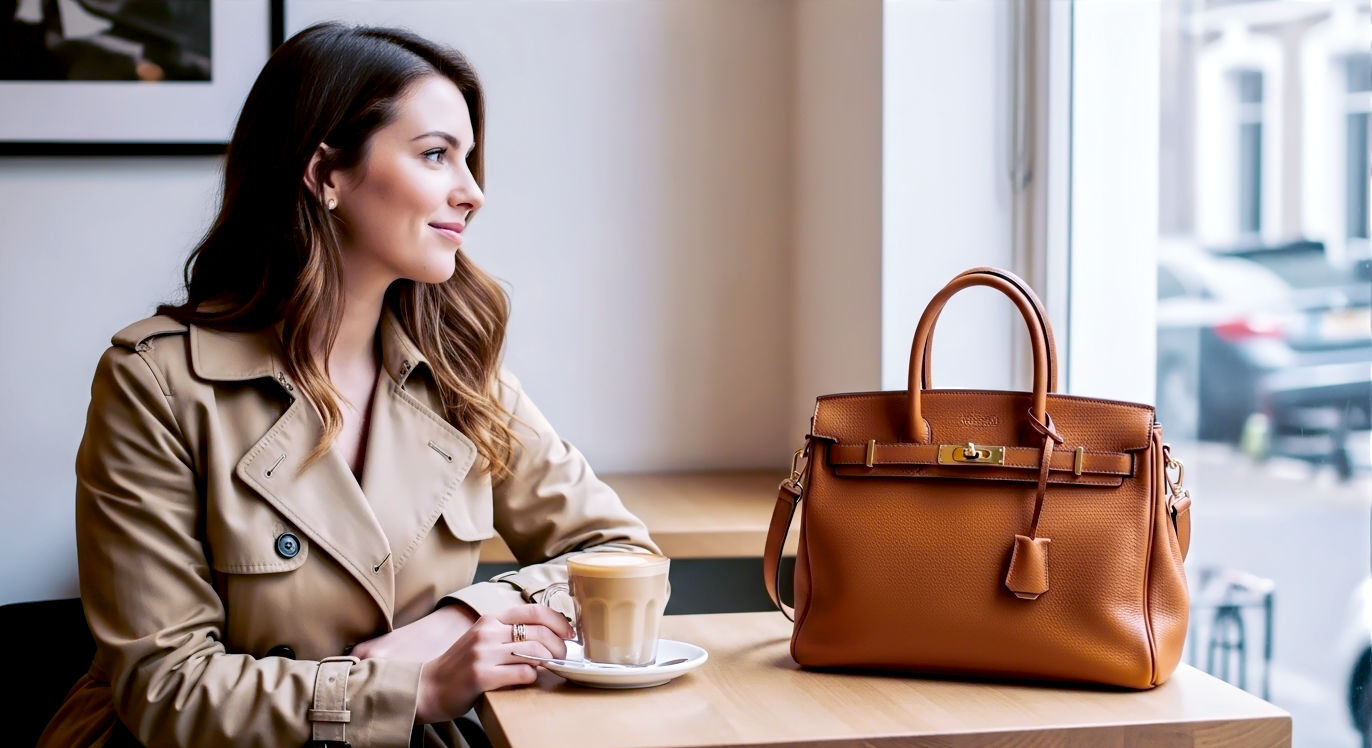How to Find Affordable Designer Bags: The Guide to Smart, Savvy & Stylish Shopping
Unlock the secrets to owning your dream designer bag for less. Our definitive guide for UK shoppers covers pre-loved sites, outlets, sales, and authentication.

This post may contain affiliate links. If you make a purchase through these links, we may earn a commission at no additional cost to you.
Let’s be honest. There’s a certain magic to a designer handbag. It’s that perfect leather smell, the satisfying clink of a well-made clasp, and the way it just seems to pull an entire outfit together. You see it online, nestled on a shelf in a glossy magazine, or swinging from the arm of someone who looks impossibly chic. You feel a pull. Then you see the price tag, and that enchanting pull turns into a bit of a punch. Four figures? For a bag? It can feel completely out of reach.
But what if it wasn’t? What if owning that beautiful piece of craftsmanship wasn’t about having a limitless bank account, but about being clever? Welcome to the world of smart shopping for designer bags. This isn’t about buying cheap knock-offs or settling for something you don’t truly love. It’s about learning the strategies, knowing the pitfalls, and mastering the art of the hunt.
This guide will show you exactly how to find affordable designer bags right here in the UK. We’ll explore the treasure troves of pre-loved luxury, navigate the famous designer outlets, and teach you how to spot a bargain (and a fake) from a mile off. Forget feeling priced out; it’s time to get savvy.
First Things First: Let’s Redefine ‘Affordable’
Before we dive into the ‘where’ and ‘how’, we need a quick chat about the word ‘affordable’. When it comes to luxury, it doesn’t mean ‘cheap’. A £50 designer bag is almost certainly a fake. Instead, we need to shift our mindset.
It’s Not About Being Cheap; It’s About Being Smart
Finding an affordable designer bag means getting exceptional value for your money. It’s about paying significantly less than the original retail price for an authentic, high-quality item. It’s securing a £1,500 Mulberry Bayswater for £600 in fantastic condition, not finding a ‘Chanel’ for £100 down the market. Smart luxury is about patience, research, and knowing what something is truly worth.
The Magic of ‘Cost-Per-Wear’
This is your secret weapon. The Cost-Per-Wear (CPW) is a simple calculation that changes how you look at price tags.
Formula: Total Cost of Item ÷ Number of Times You’ll Wear It = Cost-Per-Wear
Let’s imagine a classic, versatile black leather tote bag that costs £800. It sounds like a lot. But you know you’ll use it for work, weekends, and everything in between, at least four times a week. Over two years, that’s roughly 416 wears.
£800 ÷ 416 wears = £1.92 per wear.
Now, think about that trendy £70 high-street bag you bought. It’s a fun colour, but the strap breaks after you’ve used it 20 times.
£70 ÷ 20 wears = £3.50 per wear.
Suddenly, the ‘expensive’ bag looks like the smarter investment. A well-made designer bag is built to last for years, even decades, making its CPW incredibly low over its lifetime.
Investment vs. Trend: Choosing a Bag with Staying Power
To get a low cost-per-wear, you need a bag you’ll want to wear for a long time. While it’s tempting to grab the latest ‘It’ bag, trendy pieces can look dated in a year or two. The smartest purchases are often the classics. Think about timeless shapes, neutral colours (black, tan, navy, grey), and brands known for their enduring style rather than flash-in-the-pan designs. A Loewe Puzzle, a Chloé Marcie, or a Mulberry Alexa will still look chic long after the seasonal fads have faded.
The Savvy Shopper’s Toolkit: Where to Find Your Dream Bag for Less
Right, mindset sorted. You’re looking for value, not just a low price. So, where do you actually find these elusive, affordable designer gems? Here are the best hunting grounds in the UK.
Strategy 1: The Glorious World of Pre-Loved Luxury
The second-hand market is, without a doubt, the number one way to get a designer bag for a fraction of its original cost. It’s no longer about dusty, forgotten items; the pre-loved market is a slick, stylish, and sustainable industry.
Why Buy Second-Hand?
- Incredible Value: You can regularly find bags in pristine condition for 30-70% off the original retail price.
- Sustainability: It’s the circular economy in action. You’re giving a beautiful item a new life and reducing fashion waste. A big win for your wardrobe and the planet.
- Access to Sold-Out Gems: That limited-edition colour you missed out on three years ago? It’s probably waiting for you on a pre-loved site. You can find discontinued styles that are no longer available in stores.
Top UK Online Marketplaces
These are the digital department stores of pre-loved fashion. They act as a middleman, connecting sellers with buyers and, crucially, offering an authentication service to protect you from fakes.
- Vestiaire Collective: The biggest player in the game. It’s a huge, global marketplace where individuals and professional sellers list their items. When you buy, you can have the item shipped to Vestiaire’s expert team first. They’ll check its authenticity and condition before sending it on to you. Be mindful of potential customs fees if the seller is outside the UK.
- The Handbag Clinic: These folks are the absolute experts. They started as a repair and restoration service, so they know designer bags inside and out. They now have a fantastic retail arm selling pre-loved bags that have often been professionally cleaned and restored to look almost new. You can even visit their stores in Chelsea, Leeds, or Newcastle.
- Hardly Ever Worn It (HEWI): Another brilliant UK-based option, HEWI is known for its VIP client list, meaning you can often find items that have genuinely been worn only once or twice.
The Hidden Gems: High-End Consignment and Charity Shops
Don’t neglect the real world! Many towns and cities have fantastic consignment stores (sometimes called ‘dress agencies’) that sell pre-owned designer goods. It’s worth a Google search for ones in your local area.
And yes, you can even find gold in charity shops, especially in well-to-do areas. Think Marylebone High Street in London, or affluent towns like Alderley Edge in Cheshire. You might have to sift through a lot of duds, but the thrill of finding a genuine vintage Mulberry for £50 is unbeatable.
Strategy 2: The Thrill of the Outlet Village
If you want that brand-new-bag feeling without the brand-new-bag price, a designer outlet is your best bet. It’s a day-trip destination for bargain hunters across the country.
What Exactly is a Designer Outlet?
Outlets sell stock from previous seasons, items made specifically for the outlet store, or mainline products with tiny, often unnoticeable, imperfections. The key is that it’s all authentic and sold directly by the brand at a significant discount, typically 30-60% off.
Britain’s Best: A Nod to Bicester Village and Cheshire Oaks
- Bicester Village, Oxfordshire: This is the Buckingham Palace of bargain hunting. A beautifully designed open-air village, it’s home to boutiques from over 160 luxury brands, including Mulberry, Gucci, Prada, and Saint Laurent. It gets incredibly busy, so the best advice is to go on a weekday morning and have a list of shops you want to hit.
- Cheshire Oaks, Ellesmere Port: The largest designer outlet in the UK. It has a massive range of brands, from high-end (Burberry, Michael Kors) to premium high-street (Reiss, Kurt Geiger), offering something for every budget.
- Other notable outlets: Check out Gunwharf Quays in Portsmouth, York Designer Outlet, and the London Designer Outlet in Wembley.
Tips for a Successful Outlet Trip
- Go with a Plan: Know which brands and styles you’re looking for. It stops you from getting overwhelmed or making impulse buys.
- Inspect Everything: Check the bag thoroughly for any flaws. Ask the sales assistant if it’s an outlet-specific piece or past-season stock.
- Don’t Expect Current Season: You won’t find the bag that just dropped on Bond Street. You’ll find classics and styles from six months to a year ago.
Strategy 3: Playing the Waiting Game: Sales and Discounts
Patience is a virtue, especially in the world of luxury retail. Buying a designer bag at full price is almost always unnecessary if you’re willing to wait.
Mastering the Seasonal Sales
The two big sales periods are late June/July (for Spring/Summer stock) and late December/January (for Autumn/Winter stock). Brands and department stores like Selfridges, Harrods, and Net-a-Porter will slash prices by up to 50%. The most classic items (like a black Mulberry Bayswater) are often excluded, but you can find beautiful seasonal colours and less common styles at a fantastic price.
Black Friday and Cyber Monday: Friend or Foe?
These can be brilliant, but also chaotic. Some luxury brands participate directly, while others don’t. The best place to find a deal is often on multi-brand retailers like Farfetch, Mytheresa, or Luisaviaroma. They frequently offer site-wide discounts (e.g., 20% off) that can apply to items that are rarely on sale.
Signing Up for Newsletters: Your Secret Weapon
This is the easiest trick in the book. Sign up for the email newsletters of your favourite brands and department stores. You’ll be the first to know when a sale starts, and you’ll often get access to private pre-sales before the general public descends.
Strategy 4: Exploring Entry-Level and Diffusion Lines
If you want a brand-new bag from a coveted designer but can’t stretch to their four-figure flagship pieces, these are your best options.
What’s a Diffusion Line?
A diffusion line is a secondary collection from a high-end designer, sold at a lower price point. Think See by Chloé (from Chloé) or the former Marc by Marc Jacobs. These lines capture the main brand’s spirit but use more accessible materials and simpler construction, bringing them into a more manageable price bracket (£250-£500).
Great Brands to Start Your Collection

Some brands sit in a sweet spot known as ‘accessible luxury’. They offer fantastic quality and that designer feel without the astronomical prices of the heritage houses. Brands like Coach, Tory Burch, Kate Spade New York, and Michael Kors are brilliant starting points. They are well-made, stylish, and you can often find them for under £400, especially during sales. A Coach Tabby or a Tory Burch Kira is a fantastic first step into the world of designer bags.
Strategy 5: Try Before You Buy: The Rise of Designer Bag Rental
Okay, so this isn’t about owning a bag, but it’s an incredibly smart way to enjoy luxury for less. For a special event—a wedding, a big birthday, a fancy night out—why buy when you can borrow?
How Does it Work?
Services like Cocoon and Bagista operate on a membership model. You pay a monthly fee and get access to a revolving wardrobe of incredible designer bags. You can borrow a Bottega Veneta for a month, swap it for a Gucci, then try out a Prada. It’s a brilliant way to experiment with different styles without the commitment and discover what you truly love before you decide to invest.
Your Most Important Skill: How to Avoid a Costly Mistake
Now for the serious bit. The world of discounted luxury has a dark side: fakes. As you venture into the pre-loved market, your number one priority is ensuring what you’re buying is authentic. Getting a great deal means nothing if you end up with a worthless counterfeit.
The Authenticity Checklist: How to Spot a Fake
Learning to authenticate takes years of practice, but you can learn the basics to protect yourself. Before you even think about buying pre-loved, get familiar with the details of the bag you want. Go to a real store. Hold it. Study the real thing. Then, when you’re looking online, check these key areas.
1. Stitching: The Tell-Tale Sign
Authentic designer bags have perfect, even, and consistent stitching. There should be no loose threads, no wobbly lines, and no double-stitching. Counterfeiters often use machines that can’t replicate the precise stitch count or angle used by luxury artisans.
2. Hardware: Feel the Weight
Real designer hardware (zips, clasps, feet, logos) is heavy and substantial. It’s made of solid metal and plated properly. Fakes often use cheap, lightweight metals, plastic coated in metallic paint, or zippers that feel flimsy and catch. The engravings on the hardware should be crisp, clean, and deep, not shallow and blurry.
3. Leather and Materials: Trust Your Senses
Designers use the highest quality leathers. It should smell like rich, earthy leather, not chemicals or plastic. The texture should feel right for the type of bag—be it buttery soft lambskin or firm, structured saffiano. Check the pattern alignment on logo-heavy bags (like a Louis Vuitton or Goyard); on a real bag, the pattern will be perfectly symmetrical and won’t be cut off awkwardly by seams.
4. Logos, Stamps, and Date Codes
Examine the brand stamp inside the bag. The font, spacing, and clarity are crucial. Fakes often get this wrong—the letters might be too thick, too thin, or unevenly spaced. Many brands also use date codes or serial numbers. A quick Google search can tell you what the format should be for a specific brand and era.
“If the Price is Too Good to Be True…”
…it almost certainly is. No one is selling a genuine Chanel Classic Flap for £250. A ridiculously low price is the biggest red flag of all. Use your common sense.
Don’t Be Fooled: The Rise of the ‘Superfake’
Be aware that counterfeiters are getting scarily good. Superfakes are replicas so convincing they can even come with fake receipts and packaging. They are almost impossible for an amateur to spot. This is why buying from a reputable platform that offers professional authentication is so important. It’s your safety net.
When in Doubt, Get it Professionally Authenticated
If you’ve bought a bag from a private seller or a place without a guarantee, you can use a third-party authentication service. For a small fee, you send them detailed photos, and their experts will give you a verdict. It’s peace of mind in an email.
Common Pitfalls and How to Sidestep Them
You’re armed with the knowledge of where to look and what to look for. Here are a few final traps to avoid on your journey.
The Future of Affordable Luxury: What’s Next?
The way we shop for designer goods is changing, and it’s all good news for savvy shoppers.
- Sustainability and the Circular Economy: The pre-loved market is booming, and it’s only going to get bigger. It’s becoming cooler to buy second-hand than new. Brands themselves are even getting involved, with some launching their own certified resale platforms.
- Digital Passports and Blockchain Authentication: Technology is making it harder for counterfeiters. Soon, many new bags will come with a ‘digital passport’ using blockchain technology. This will create an un-falsifiable record of the bag’s history, making it completely secure to buy and sell on the second-hand market.
Your Journey Starts Now: A Final Word
The world of designer handbags doesn’t have to be an exclusive club with a high price of entry. With a little bit of knowledge, a healthy dose of patience, and a smart strategy, you can absolutely own the bag of your dreams.
It’s about celebrating craftsmanship and style in a way that’s sustainable for your wallet and the planet. It’s the thrill of the hunt and the deep satisfaction of knowing you found something beautiful for a truly fantastic price. So, go on. Start your research, browse the pre-loved sites, plan that outlet trip. Your dream bag is out there waiting for you—and you’re now perfectly equipped to find it.
Further Reading
For those looking to dive even deeper, these resources are invaluable:
- Vogue Business: For insights into the luxury market and sustainability trends.
- The Handbag Clinic: Explore their blog for expert advice on bag care, authentication, and restoration.
- Vestiaire Collective: Browse their vast collection to get a feel for pre-loved market prices.
- PurseBlog: A fantastic resource for news, reviews, and in-depth discussions on everything related to designer handbags.







